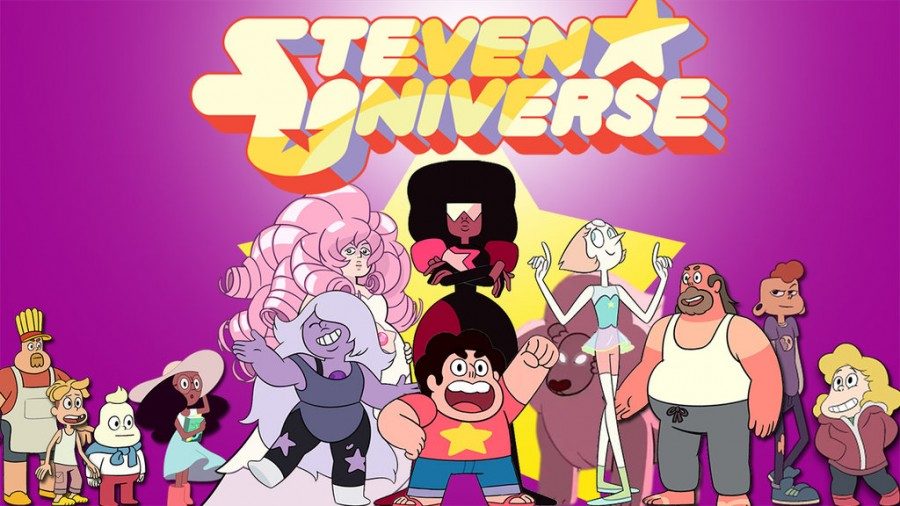How ‘Steven Universe’ serves as metaphor for trans experience
“Steven Universe” is a children’s cartoon which has revolutionized the social capacity of television series in our society. In each 11-minute episode, the show takes a lighthearted approach in examining complex topics from gender roles to race and so many others.
Unlike most television shows and movies, “Steven Universe” normalizes marginalized identities and “nontraditional” lifestyles, like family makeup, rather than use them as a plot point with which the character has to wrestle. For example, no one is confused or raises an eyebrow that most “gems” are lesbians, and no one questions that Steven is being raised by three gems who identify as women, even though none of them are biologically his mother.
To people who are queer or are in “nontraditional” families, it is refreshing to see someone else living this reality, rather than seeing your experience as negative or an ongoing struggle.
While the gender binary, gender roles and gender fluidity are constantly critiqued through the tenderness of Steven, the stoicism of Garnet, the filthiness of Amethyst and so many others, gender identity is not an openly examined topic.
If you look a little deeper, it is clear that some characters embody experiences similar to some transgender people.
Most clearly, Stevonnie, the fusion of Steven and Connie, uses they/them pronouns and is a literal combination of a boy and girl.
When someone asks if Stevonnie is Steven or Connie, Garnet responds that Stevonnie is neither. Stevonnie is an experience; that is to say, people who are non-binary do not identify as one or both genders, but neither. Additionally, Stevonnie is an androgynous character that retains their feminine features, like long hair and hips.
While Stevonnie may be a clearer example of a trans character, Steven is a transmasculine person.
The first sign is that his mother, Rose Quartz, gave up her form so Steven could be born. She literally transitioned to Steven. Though Rose had a successful and happy life that was filled with love, she felt incomplete and that she was meant to be a human, or man, but was still a gem, or woman.
When Rose transitioned to Steven, he was able to navigate in the human world, but still had a gem that influences his identity and experiences. Though Steven has two parents, Rose Quartz and Greg Universe, there is no proof that Greg contributed to the conception of Steven because gem reproduction is never discussed.
When Steven Universe is born, he is human but retains Rose Quartz’ gem and the powers that come with it. He is not just a human, he is a human and gem, or genderqueer. This is the conflicted identity that many transfolk face, not being completely accepted into men’s or women’s spaces but with insight into both experiences.
The Crystal Gems take in the mysterious Steven Universe because Rose Quartz was their best friend. He is considered a gem, because he has those powers that the gems have but is still different. All gems use she/her pronouns, but Steven uses he/him pronouns. This new addition necessitates that the gems expand their concept of what a “gem,” or woman, is because they grow to love and learn about Steven and accept that humans can be gems too.
That being said, Steven exists in both of these worlds, symbolizing that he is on the gender spectrum as a transmasculine person, not on the binary as a cisgender man or trans man.
Steven shows that there is not a binary between gems and humans, just like there is not one when it comes to gender identity. Rebecca Sugar, the show’s creator, illustrates gender identity by using gem/human symbolism to allow her viewers to gain a new perspective on gender. This doubles as a tool to make “Steven Universe” a simple show for children.
Do not take my word for the hidden complexities in “Steven Universe.” Watch the show yourself — you won’t regret it.
Your donation will support the student journalists of Tulane University. Your contribution will allow us to purchase equipment and cover our annual website hosting costs.




Grace • Apr 21, 2017 at 10:50 am
I never thought of Steven that way. Thank you for opening my eyes to the symbolism. (I honestly didn’t think of the Steven representing Transition in a way). It’s defiantly clever.
Fred • Apr 21, 2017 at 10:36 am
“Though Steven has two parents, Rose Quartz and Greg Universe, there is no proof that Greg contributed to the conception of Steven because gem reproduction is never discussed. ”
Ye-es:
‘Steven: they tried to take me hostage ’cause they think I’m my mom. And… maybe I kinda am?’ (Joy Ride)
But:
‘Rose: I’m going to become half of you.’ (Lion 3: Straight To Video)
‘Steven: I’m magic. Well, half-magic, on my mom’s side.’ (Bubble Buddies)
Peridot: Yeah, you’re some kind of quartz, right? You must have been made here.
Steven: I came from my mom and dad.
Peridot: Are those some kind of rocks? Or another planet?
Steven: Nope. My dad is from Earth, but my mom’s a Gem.
Peridot: You’re some sort of… hybrid? How is that possible?
Steven: The answer to that is a story I like to call, “The Ballad of Rose and Greg”.
(When It Rains)
So although we don’t have any specific details (this is a kid’s show, after all) It’s pretty clear that Greg had at least some part in Steeven’s conception, especially as Steven is clearly a biological organism (he needs to eat, sleep, use the bathroom etc., while the other gems don’t ‘have to’ but often choose to) while Rose wasn’t, Gems being basically sentient rocks with bodies made out of solid light.